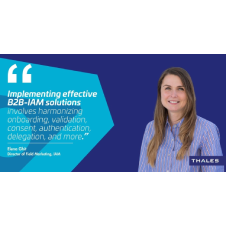Identity first: Best Practices of B2B IAM
madhav
In today’s evolving landscape of distributed workforces, the once well-defined boundaries of the corporate network have blurred into obscurity. The rise of remote work has shattered the traditional notion of a fortified perimeter, leaving organizations grappling with the challenge of securing identities rather than relying on sentinels at the gate to keep undesirable elements out. Moreover, in today’s fast-changing digital economy, effective collaboration with business partners, vendors, and the supply chain is essential for the success of any business. As corporations often provide portals to enhance the collaboration, the complexity of managing numerous external identities and access permissions becomes apparent. Traditional identity management models often entail labor-intensive administrative processes, slow response times, and, inadvertently, introduce security vulnerabilities and user experience friction.
With this thought in mind, in London, on 4 and 5 March, Gartner is hosting the annual Identity & Access Management Summit, this year themed Identity-First Security: Simplify. Enable. Protect. Attendees will have the opportunity to participate in interactive and collaborative sessions, share their experiences, and get their hands on the latest research to help them bring their businesses into today’s identity-first era.
Safeguarding identities
Recent changes in the way we work with the internal colleagues and how we collaborate with external parties have seen identity infrastructure emerge as the new frontline in the ongoing battle against cyber threats.
As attackers adapt their tactics to exploit vulnerabilities in this decentralized model, safeguarding identities has become key to protecting the integrity of businesses and ensuring the confidentiality of sensitive data.
Unfortunately, identity and access management (IAM) systems that still use a legacy approach to manage the identities of users and devices across burgeoning lists of applications and environments have become obsolete.
They are cumbersome, complex, and cannot adapt quickly enough to prevent today’s threats.
Managing access at scale
In addition, today’s interconnected business landscape sees supply chains span multiple organizations and geographical regions and needs to tackle the complex task of securely managing access to business applications at scale.
Implementing effective B2B-IAM solutions involves harmonizing onboarding, validation, consent, authentication, delegation, and more, which yesterday’s systems cannot manage effectively.
Robust B2B-IAM requires clear governance frameworks, standardized protocols, and seamless interoperability between disparate systems.
By addressing these challenges head-on, businesses can streamline collaboration, mitigate security risks, and foster trust among supply chain partners, ultimately enhancing resilience and competitiveness in the global marketplace.
Identity first, always
An identity-first approach to security is a paradigm shift that places the concept of identity at the core of an organization’s security strategy. In a rapidly evolving digital landscape, where cyber threats are becoming more sophisticated and pervasive, traditional security measures alone may fall short.
By prioritizing identity as the linchpin of security, entities can build a robust defense against cyber threats while facilitating a more agile and user-friendly environment.
Identity-first security also recognizes that individuals and entities accessing a network or system are at the heart of security vulnerabilities.
Today’s users access applications across a wide range of cloud platforms, virtual environments, networks, and web portals. Companies with no central IAM strategy are in danger of security breaches and lost productivity.
- Businesses put themselves at risk of data breaches stemming from compromised identities
- IT administration costs soar thanks to inefficient identity management
- User productivity plummets as password fatigue and password resets take hold
- A lack of visibility into cloud access events hampers regulatory compliance
This means security practitioners need to rethink their IAM and adopt an identity-first approach that places identity-based controls at the core of the business’s security design. Many, however, do not know where to start.
Rethinking IAM
If you are rethinking your IAM strategy, don’t miss Thales’s IAM Business Acceleration Director, Marco Venuti, talk at the Gartner IAM Summit, Thales: Best Practices of B2B IAM to Streamline Third-Party Interactions. His session will explore the confluence of real-world scenarios and current market solutions in Business-to-Business Identity and Access Management (B2B-IAM).
He’ll also cover how Thales Identity and Access Management solutions can effectively address identity challenges and ensure secure cloud adoption in the organization via a range of key functionalities:
- Cloud access is simplified through cloud single sign-on (cloud SSO)
- Security is optimized via granular access policies
- Scalability is enabled through centralized management
- Compliance is enhanced through visibility into cloud access events
Another of the key strengths of the Thales solution is its ability to seamlessly integrate with existing IT infrastructure and cloud platforms, enabling organizations to extend their security policies and controls across diverse environments. Whether securing access to SaaS applications, managing identities in IaaS platforms, or enforcing data protection policies in PaaS environments, Thales IAM solutions provide a unified approach to identity-centric security.
To learn about identity-first security, attend Marco’s Gartner IAM Summit session.

*** This is a Security Bloggers Network syndicated blog from Thales CPL Blog Feed authored by madhav. Read the original post at: https://cpl.thalesgroup.com/blog/access-management/best-practices-of-b2b-iam-summit-by-gartner
